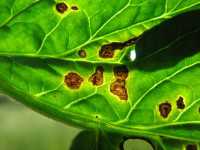Insight On Controlling Bacterial Canker In Tomato

“It was such a bad disease year,” said Sally Miller, a plant pathologist at The Ohio State University, to a crowded room of attendees at the Great Lakes Fruit, Vegetable & Farm Market Expo in Grand Rapids, MI, this week. “When you have rain like we had, you will have the potential for very severe disease problems.”
Going back nearly three years to 2009, she says there has been a bacterial leaf spot epidemic in processing tomatoes in Ohio and Michigan. “Instead of the tomatoes having smaller scabs, there were larger lesions that don’t peel off, which is a problem for the processor and the growers get their loads rejected or reduced payments,” she explains.
Another serious disease, continues Miller, is bacterial canker, a vascular pathogen that gets inside the plant. Infected plants will show stunting and can die. Some symptoms include fruit spots, wilting, and small fruit. This disease doesn’t occur in Florida, she says, because the climate is too hot. Canker is typically seen in cooler climates.
According to Mary Hausbeck, who is in the plant pathology department at Michigan State University, bacterial canker was a big issue this past season in Michigan and New York. “When the infection incurs very early on, growers’ plants don’t produce,” she explains. “You can have canker come in late [in the season], but it really doesn’t ruin your season. It is when bacterial canker comes at the transplant stage or before that — that is when growers can expect devastating yields.”
It is important to note, continues Hausbeck, that bacterial canker doesn’t spontaneously appear and the weather can’t cause the bacteria to appear. The weather is an influencing factor, but the bacteria have to be introduced from somewhere — such as the seeds or from residue in the fields.
For example, in the greenhouse overhead watering can help spread bacteria from infected transplants to nearby transplants. The water splashes from plant to plant, spreading the canker. Plants in the greenhouse that show signs of the disease need to be removed and destroyed as growers do not want to plant infected tomatoes in the field. Often nearby plants in the greenhouse that show no signs of the disease need to be destroyed, too.
Hausbeck suggests using a seed treatment to try to eradicate the bacteria. For growers who choose not to treat seed, she says that copper can be used in an attempt to control bacterial disease in the greenhouse and in the field. In fact, Hausbeck suggests using copper sprays beginning with the first set of true leaves and reapply every five days. For bacterial canker in the field, Hausbeck tells growers to spray immediately and maintain a five-day spray program.
“You’ll know if you have bacterial canker in the field because you will see the dark fringing on the leaves,” she adds.
For more information, go to http://anrcom.msu.edu/news/article/keep_bacterial_diseases_away_from_vegetable_transplants.










